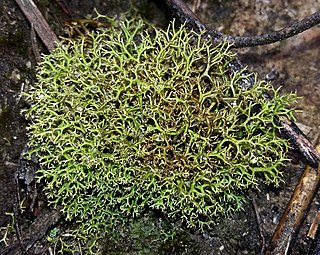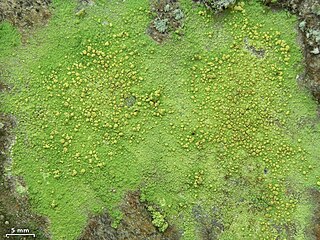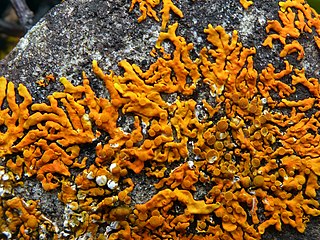
The Parmeliaceae is a large and diverse family of Lecanoromycetes. With over 2700 species in 71 genera, it is the largest family of lichen-forming fungi. The most speciose genera in the family are the well-known groups: Xanthoparmelia, Usnea, Parmotrema, and Hypotrachyna.

The Ramalinaceae are a family of lichenized fungi in the order Lecanorales. The family name is synonymous with the name Bacidiaceae. Species of this family have a widespread distribution.

The Physciaceae are a family of mostly lichen-forming fungi belonging to the class Lecanoromycetes in the division Ascomycota. A 2016 estimate placed 19 genera and 601 species in the family.

The Graphidaceae are a family of lichen-forming fungi in the order Graphidales. The family contains nearly a hundred genera and more than 2000 species. Although the family has a cosmopolitan distribution, most Graphidaceae species occur in tropical regions, and typically grow on bark.

Ramalina is a genus of greenish fruticose lichens that grow in the form of flattened, strap-like branches. Members of the genus are commonly called strap lichens or cartilage lichens. Apothecia are lecanorine.

Cladia is a genus of lichen-forming fungi in the family Cladoniaceae. Cladia species have a crustose or squamulose (scaly) primary thallus and a fruticose, secondary thallus, often referred to as pseudopodetium. The type species of the genus, Cladia aggregata, is widely distributed, occurring in South America, South Africa, Australasia and South-East Asia to southern Japan and India. Most of the other species are found in the Southern Hemisphere.
Septotrapelia is a genus of lichen-forming fungi in the family Pilocarpaceae. It has four species. It was validly published as a genus in 2007 by lichenologists André Aptroot and Jose-Luis Chaves.

Psilolechia is a genus of four species of crustose lichens. It is the only member of Psilolechiaceae, a family that was created in 2014 to contain this genus.

Enterographa is a genus of lichens in the family Roccellaceae.

Parmotrema is a genus of lichen belonging to the family Parmeliaceae. It is a large genus, containing an estimated 300 species, with a centre of diversity in subtropical regions of South America and the Pacific Islands.
Physma is a genus of cyanolichens in the family Pannariaceae. It has five species. The genus was circumscribed by Italian lichenologist Abramo Bartolommeo Massalongo in 1854, with Physma boryanum assigned as the type species.
André Aptroot is a Dutch mycologist and lichenologist. His primary research focus is on biodiversity, particularly tropical lichens, encompassing systematics, floristic surveys, and taxonomic reviews. A prolific researcher, he has published more than 500 scientific papers and described hundreds of new fungal and lichen species.

Loxospora is a genus of lichen-forming fungi in the family Sarrameanaceae. It has 13 species. The genus was circumscribed by Italian lichenologist Abramo Bartolommeo Massalongo in 1852, with Loxospora elatina assigned as the type species. This crustose lichen was originally named Lecanora elatina by Erik Acharius in 1810.
Klaus Kalb is a German lichenologist and an authority on tropical lichens.

Dufourea is a genus of mostly foliose lichen species in the subfamily Xanthorioideae of the family Teloschistaceae. Species in the genus are found in the Southern Hemisphere.
Henricus (Harrie) Johannes Maria Sipman is a retired Dutch lichenologist who specialised in tropical and subtropical lichens and authored or co-authored over 250 scientific publications. He was the curator of the lichen herbarium at the Berlin Botanical Garden and Botanical Museum from 1983 until his retirement in 2010.
Mark Richard David Seaward is a British ecologist and lichenologist. He was awarded the Acharius Medal in 2006 for lifetime contributions to lichenology.
Celotheliaceae is a family of fungi in the monotypic order Phaeomoniellales. It contains 27 species of crustose lichens with thalli that are more or less immersed in tree bark.

Nigrovothelium is a genus of lichen-forming fungi in the family Trypetheliaceae. It has three species. The genus was circumscribed in 2016 by lichenologists Robert Lücking, Matthew Nelsen, and André Aptroot, to contain species formerly in the Trypethelium tropicum species group. The type species, Nigrovothelium tropicum, was originally described by Erik Acharius in 1810, as a species of Verrucaria.

Robert Lücking is a German lichenologist, known for his extensive research on foliicolous lichens and his significant contributions to the taxonomy, ecology, and biodiversity of fungi and lichens. He earned his master's and PhD from the University of Ulm, focusing on foliicolous lichens. He has received numerous awards for his work, including the Mason E. Hale Award for his doctoral thesis, the Augustin Pyramus de Candolle prize for his monograph, and the Tuckerman Award twice for his publications in the scientific journal The Bryologist.












